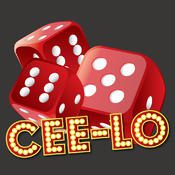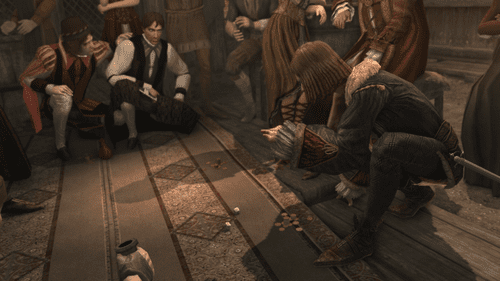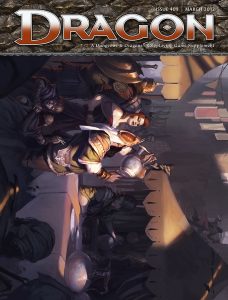Gambling in RPG Games

If you have ever heard your players talk about gambling during downtime for their characters, then you might not know how to handle it. A quick & dirty way is to ask them, “How much do you want to wager for an hour (or entire night)?” Then roll some percentile dice; roll from 1 to 75 they lose money, 76 to 100 they win money. Set the payout multiplier to 1d6. Use that odds multiplier, and then tell them how much lost or won for the hour(or night). A player risks losing more than they start out wagering because that’s how gambling works. People keep gambling, because they are trying to win back what they’ve lost.
As an example, a player wants to wager 100 blue dragons (whatever you call your money). They roll a 74, and the payout is set by rolling a d6 which results in a 3. So they lose a total 300 blue dragons (3x their starting 100 wager). If they don’t have the money to cover their losses, then that may be a great opportunity for an encounter with the local crime ring.
Another scenario, is maybe you don’t want to just have a d20 dice-off for a magic item that is wanted by two players. Realistically, the player characters might pull out a deck of cards or some dice to determine who gets what. Simulating gambling with actual games of chance, have it be blackjack or some other modern game would be pretty nifty. I just take a game like Black Jack, and just modify the name to give it flavor. Say Dragon Deuces, and then change the rules a bit. And instead of 21, the object is 22.
There are many many games out there that can be used, and since you probably have a table full of dice, then I lean toward dice games. Here are a few simple dice games that you can use, and with one from Dragon Magazine a few years ago:
Chinchirorin
Sticking with some of my games, Wuxia flavor, I’ve found a three dice game called Chinchirorin, or Cee-Lo. The game is fairly simple with the House taking bets from any number of players at once.

There are any number of players that bet and place their stakes into a pot. Each player then rolls 3 dice all at once and the dice rolls are compared. Who ever has the best combination wins all of the pot. The game is restarted. If players tie then they have a shootout with the same rules to determine a winner. Here are the combinations and their rankings:
- 4-5-6 “4-5-6 straight kill” (四五六通杀), “leopards” (豹子 baozi)
The highest possible roll. If you roll 4-5-6, you automatically win. - Triples
Rolling three of the same number is known as rolling “trips”. Higher trips beat lower trips, so 4-4-4 is better than 3-3-3. - Point
Rolling a pair, and another number, establishes the singleton as a “point”. A higher point beats a lower point, so 2-2-6 is better than 5-5-2. - 1-2-3 “1-2-3 straight lose” (一二三通赔) and “#$%hole ones” (幺屁眼)
The lowest possible roll. If you roll 1-2-3, you automatically lose.
Re-roll. If the dice don’t show any of the above combinations, then you all will roll again if no one rolled a 4-5-6, Triples or Point.
Hazard
Hazard is an old English gambling game mentioned in Canterbury Tales in the 14th century. Hazard is played with two six sided dice. The caster calls a number from 5 to 9, the Main. The caster then attempts to throw the two dice that will added up to the Main. You can call the game other things like Risk, Aversion, King’s Gambit or whatever. The game is the father of modern Craps. In Craps, the main is set at 7.
First Roll
The caster throws two dice and tries to match the Main that he set, either by choice, or the house has the number determined randomly.
Winning (Nicks). Rolling the Main, or sometimes 11 or 12 (see table)
Losing (Outs). If a total of 2 or 3 is rolled, then the caster loses, or sometimes 11 or 12 (see table)
Chance. If a Nick or Out isn’t rolled then it’s called a Chance. Then the caster rolls again to match Chance.
| Main | Nicks | Outs | Chance |
|---|---|---|---|
| 5 | 5 | 2,3,11,12 | 4,6,7,8,9,10 |
| 6 | 6,12 | 2,3,11 | 4,5,7,8,9,10 |
| 7 | 7,11 | 2,3,12 | 4,5,6,8,9,10 |
| 8 | 8,12 | 2,3,11 | 4,5,6,7,9,10 |
| 9 | 9 | 2,3,11,12 | 4,5,6,7,8,10 |
Chance – Keep Rolling…
After the first roll, then the games moves into Chance. The caster keeps rolling until the set Chance number comes up, or the Original Main number comes up.
Winning. If the second roll is the Chance then the caster wins.
Losing. If the second roll is the Main, then the caster loses.
Roll Again. If the Chance or Main wasn’t rolled, then the caster keeps rolling until either turns up.
Payout
When the dice caster wins on the first throw, he wins at 1:1 odds, and gains what he bet. But if the game moves into Chance, then the odds are better on different numbers than others. The caster will receive his original stake at 1:1, but additional betting would have odds based on the Main & the Chance numbers.
Here is the payout table for different Mains & Chance numbers:
| Main | Chance | ||||||
|---|---|---|---|---|---|---|---|
| 4 | 5 | 6 | 7 | 8 | 9 | 10 | |
| 5 | 4/3 | — | 4/5 | 2/3 | 4/5 | 1/1 | 4/3 |
| 6 | 5/3 | 5/4 | — | 5/6 | 1/1 | 5/4 | 5/3 |
| 7 | 2/1 | 3/2 | 6/5 | — | 6/5 | 3/2 | 2/1 |
| 8 | 5/3 | 5/4 | 1/1 | 5/6 | — | 5/4 | 5/3 |
| 9 | 4/3 | 1/1 | 4/5 | 2/3 | 4/5 | — | 4/3 |
As an example; The caster sets the main at 7, and bets 100 gp. He rolls a 4. So the game moves into chance.
He then bets the house another 100 gp, and rolls a 5, doesn’t bet anymore, and rolls a 8, 11, and then finally rolls a 4 and wins. His payout would be 100 plus 100 x 2 for 300 gp winnings and return of the 200 gp stakes. Anyone else can bet during chance, and they would also win at the 2 for 1 payout.
Goblin Army
 This is a game that can be found in the March 2012 DRAGON Magainze number409 , and it was credited to Dave Chalker. It’s more complicated than the other games, and involves bluffing and some in-game skill character rolls. You might like it.
This is a game that can be found in the March 2012 DRAGON Magainze number409 , and it was credited to Dave Chalker. It’s more complicated than the other games, and involves bluffing and some in-game skill character rolls. You might like it.
An old dwarven saying goes, “Never trust a goblin that boasts of the size of its army.” Goblin Army is a bluffing game that is said to originate from that proverb, in which gamblers wager on the size of a particular “army” by looking at different-sized dice in front of them and guessing what the other players
have.
Players. 2 to 6
Components. Each player needs a set of 1d4, 1d6, 1d8, 1d10, and 1d12. A cup to hide the dice for each player is optional but recommended.Setup
Everyone rolls all their dice in the open to determine the starting player. The player with the highest numeral showing goes first. If there’s a tie, compare players’ second-highest dice, and so on.Stakes
The players mutually decide on the initial stakes. Each player antes the agreed amount into the pot at the start of a hand. The size of the pot might go up during the course of the game. After the stakes are decided for a new hand, if the amount is too rich for a player, he or she can drop out.Starting a Hand
Each player secretly rolls his or her set of dice, hiding the result; a dice cup is useful for this purpose. Be careful not to change the results of the roll when hiding the dice. You can check your own dice at any time during the hand.Play
The first player in a new hand makes a bid, naming the quantity of a given numeral rolled among all players.For example, a bid of three 3s is a prediction that at least three dice among all players’ rolls are showing a 3 (including wild rolls, as described below).
Wild Rolls. Rolls of 1, 10, 11, and 12 are treated differently from others. Any instance of the numeral 1 is wild: It can count as any value for a bid. Thus, each die showing a 1 is wild; a 10 has one 1 and one 0, so it counts as a roll of 1 (wild); an 11 shows two 1s and thus counts as two wilds; a 12 counts as one wild and one 2. Once a player has made a bid, play passes to the left. That player can either raise or challenge.
Raise
A player raises by making a new bid that increases one of the numbers in the previous bid (either the quantity rolled or the value showing on the dice). For example, a bid of three 3s can be raised to either four (or more) 3s or three 4s (or a higher value). Neither number can be decreased; for example, you cannot raise a bid of three 3s with a bid of four 2s, because 2 is lower than the previous bid’s dice value. After a player raises, play continues to the left as normal.Challenge
If a player chooses to challenge, all players reveal their dice. The most recent bid is assessed to see if it was correct or not. If the number of dice showing the bid value (including wild rolls) equals or is higher than the number bid, that bidder wins the hand. If the number is lower than the bid, the challenger wins the hand.For example, someone challenges a bid of three 3s. Two dice among all the players are showing 3s, and another one shows a 1 (which is wild), for a total of three 3s. The challenge fails, and the most recent bidder wins the hand.
Whoever wins the hand (the challenger or the bidder) takes the pot. The loser can then choose to double the stakes for the next hand or keep them the same. Players then have the option to drop out. All the remaining players roll all their dice again, and the winner of the previous hand makes the first bid. Play continues until one player remains.
INFLUENCING GOBLIN ARMY
Bluffing and reading the other players are the two most important skills in Goblin Army. The GM can represent these skills against nonplayer opponents by making opposed checks. If a player character makes a successful Charisma/Bluff/Deception/Lie check opposed by the next opponent’s Wisdom/Insight/etc. check, you can convince that opponent not to challenge (unless the bid was outrageously high).Likewise, a successful Wisdom check opposed by the previous opponent’s Charisma check might reveal whether that person is bluffing.
I hope you can use some of this in your games, and there are so many games that can be used in different settings. Check some more out here: https://en.wikipedia.org/wiki/Category:Dice_games
Links
[http://www.britannica.com/topic/grand-hazard]
[https://en.wikipedia.org/wiki/Hazard_%28game%29]
[http://archive.wizards.com/DnD/TOC.aspx?x=dnd/4new/drtoc/409]
[http://www.d20pfsrd.com/gamemastering/other-rules/gambling-and-games-of-chance]



